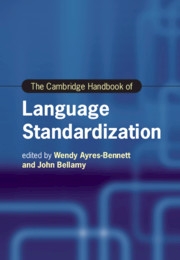Book contents
- The Cambridge Handbook of Language Standardization
- cambridge handbooks in language and linguistics
- The Cambridge Handbook of Language Standardization
- Copyright page
- Contents
- Figures
- Tables
- Contributors
- Introduction
- Part I Revisiting Models and Theories of Language Standardization
- Part II Legitimacy, Authority and the Written Form
- Part III Norms, Literacy and Education
- Part IV Beyond the National
- Part V Standardization in Late Modernity
- 25 Destandardization
- 26 Contemporary Perspectives on Language Standardization
- 27 Standardization and New Urban Vernaculars
- 28 Renegotiating Language Norms in Minority Contexts
- 29 Sign Language Standardization
- Name Index
- Subject Index
- References
28 - Renegotiating Language Norms in Minority Contexts
from Part V - Standardization in Late Modernity
Published online by Cambridge University Press: 01 July 2021
- The Cambridge Handbook of Language Standardization
- cambridge handbooks in language and linguistics
- The Cambridge Handbook of Language Standardization
- Copyright page
- Contents
- Figures
- Tables
- Contributors
- Introduction
- Part I Revisiting Models and Theories of Language Standardization
- Part II Legitimacy, Authority and the Written Form
- Part III Norms, Literacy and Education
- Part IV Beyond the National
- Part V Standardization in Late Modernity
- 25 Destandardization
- 26 Contemporary Perspectives on Language Standardization
- 27 Standardization and New Urban Vernaculars
- 28 Renegotiating Language Norms in Minority Contexts
- 29 Sign Language Standardization
- Name Index
- Subject Index
- References
Summary
This chapter considers language standardization from a minority language perspective. Processes and underlying principles of evaluative frameworks in minoritized languages are described from a historical and contemporary perspective. Trends in the standardization of minority languages are outlined, focusing on the case of the Irish language. It is contended that models of language excellence in many minority situations are being restructured. This is due to the opportunities for engagement with, and evaluation of, new forms of variation that have resulted from generations of language shift and revitalization. It is also due to the changing relationship between self and society in the context of Late Modernity, where social actors are increasingly agentive in deciding what is right and wrong for themselves. Using Irish as an illustrative example, it is shown that models of legitimate, authoritative and authentic language usage are constantly available for renegotiation, and perhaps especially in minority contexts. Results are described from two attitudinal projects with users of Irish, one with teenagers from the Irish-speaking communities of the Gaeltacht and the other with prospective ‘New Speaker’ teachers of Irish. Ultimately, the chapter speaks to shifting language evaluative dynamics in minority languages as communities adapt to their minoritized status within the fluid sociolinguistic arrangements that characterize Late Modernity.
- Type
- Chapter
- Information
- The Cambridge Handbook of Language Standardization , pp. 741 - 764Publisher: Cambridge University PressPrint publication year: 2021



